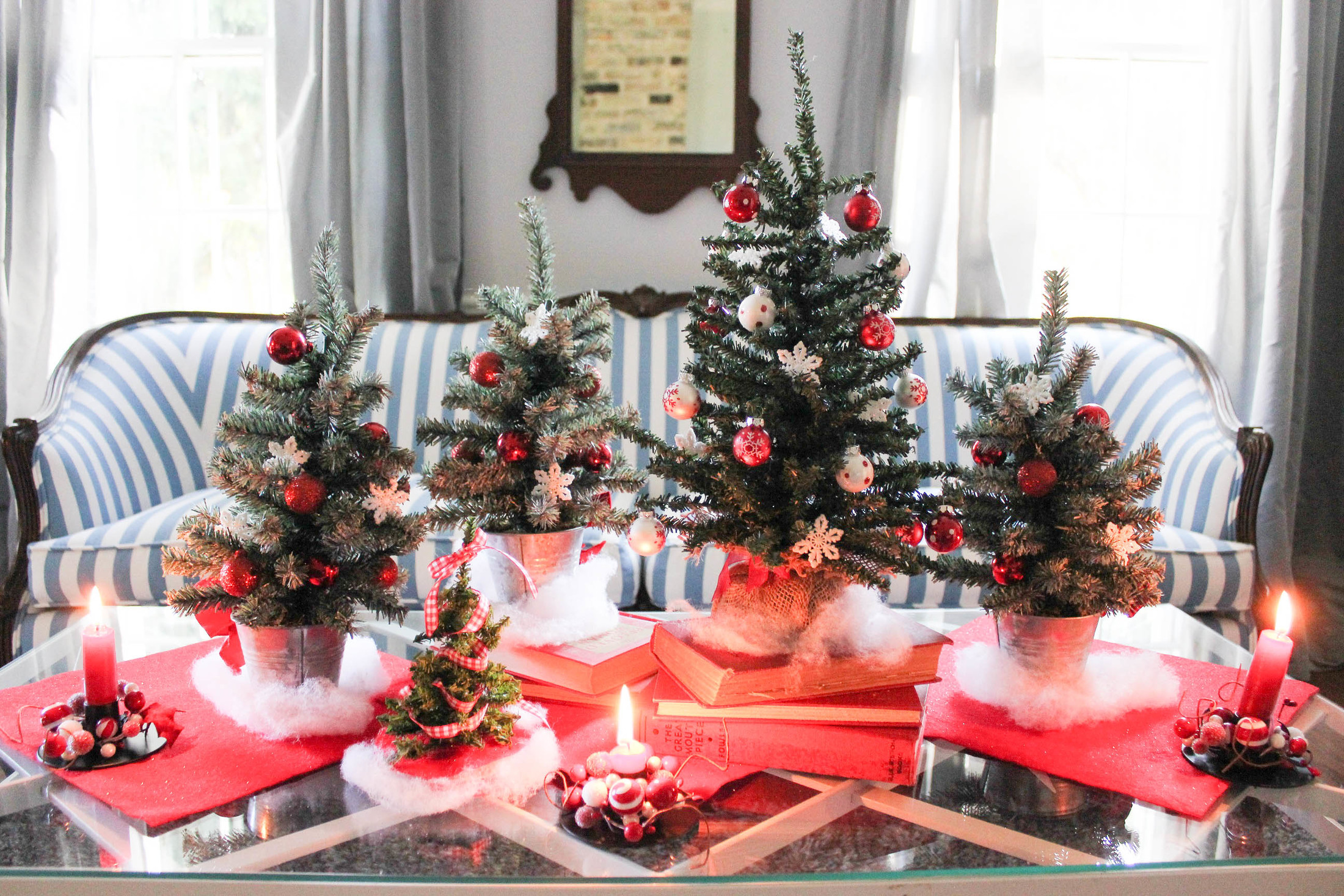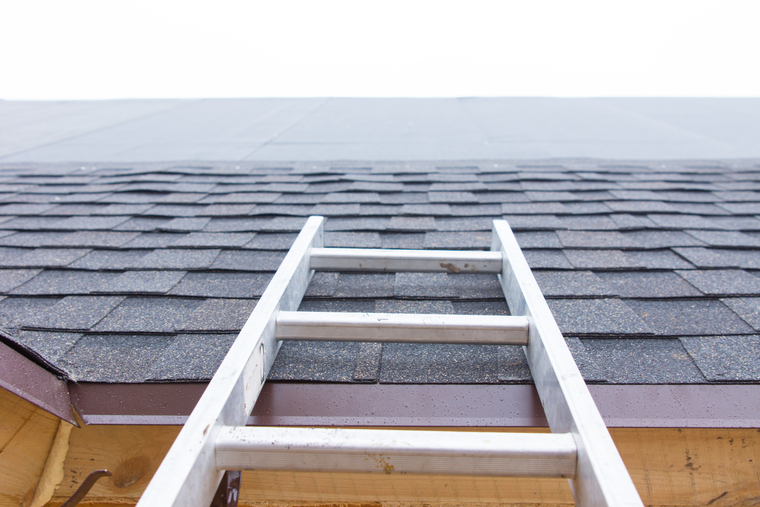Personalize Your Home with Christmas Tree Centerpieces

 December is a busy month with Christmas around the corner, so I try to do as many tasks in advance as I can — if not my shopping, at least my decorating!
December is a busy month with Christmas around the corner, so I try to do as many tasks in advance as I can — if not my shopping, at least my decorating!
In November, I decide on my decorating theme for the season. I like to introduce a few new decorations every year — this year, I chose an abundance of artificial trees.
Artificial trees come in a variety of sizes and color options. Choose from natural shades of green to frosted white to whimsical pink and silver. I used a trio of 15-inch snowy pines “planted” in galvanized tins, but you can opt for larger trees depending on the size of your table and room. If you have a large dining table and high ceilings, trees as large as two or three feet add a dramatic look that’s perfect for holiday parties. If you choose pre-decorated trees, you’re already halfway done!
I added two more trees to complete the table: a large 18-inch pine and a matching mini version. Having similar items of varying heights makes any display more interesting. I used vintage books with faded red covers to add height to the arrangement, then finished with red and white ornaments, snowflakes and a red table runner to make everything more festive.
I decorated the mini tree simply, with just a gingham ribbon and used a piece of quilt batting as the “snow” surrounding each tree. A Christmas scene wouldn’t be complete without candlelight, so I made candle rings from a decorative red and white garland twisted around petite candle tapers.
If you want to extend your tablescape, try these other centerpiece ideas:
- Light up the room with battery-powered lights strung on each tree.
- Decorate artificial trees in a color scheme that matches your room’s decor. It may be Christmas, but that doesn’t mean everything has to be red and green!
- Have a small decorated tree at each place setting at your dining room table. Host a dinner party and have your guests take the trees home as party favors.
It doesn’t take much to create a “tree-mendous” centerpiece that you and your guests will love.
For more information on Windermere please contact us here.
Here’s Your Fall Home Maintenance Checklist:


Fall is an ideal time to tackle maintenance projects both inside and outside. Here are a few ideas to get you started:
Gutters top to bottom: Water in the wrong spots can do a lot of damage. Start by ensuring that gutters downspouts are doing their job. (Don’t attempt this task yourself if you have a two-story house with a steep roof; hire a professional instead.) If your home is surrounded by deciduous trees you may need to clean out your gutters a few times a year, especially in the fall. Check to make sure your gutters are flush with the roof and attached securely, repairing any areas that sag or where the water collects and overflows. Clean out the gutters and downspouts, checking that outlet strainers are in good shape, and are firmly in place. Finally, check that your downspouts direct water away from your house, not straight along the foundation.
If you haven’t already, you may want to consider installing gutter guards. Gutter guards create a barrier so water can get through to your gutters, but debris cannot, limiting gutter buildup (and the time you spend cleaning out your gutters). There are DIY installation kits available or you can always hire a professional to install a gutter guard system.
If you have a sump pump under your house, now is a good time to test it. Run a hose to be sure draining water travels directly to the pump (dig small trenches if needed), and that the pump removes the water efficiently and expels it well away from the foundation. For more information about how sump pumps work go to howstuffworks.com.
Check for leaks: The best opportunity to catch leaks is the first heavy rain after a long dry spell, when roofing materials are contracted. Check the underside of the roof, looking for moisture on joints or insulation. Mark any spots that you find and then hire a roofing specialist to repair these leaks. What you don’t want to do is wait for leaks to show up on your ceiling. By then, insulation and sheet rock have been damaged and you could have a mold problem too.
Don’t forget the basement. Check your foundation for cracks, erosion, plants growing inside, broken windows, and gaps in window and door weathering. Make sure to properly seal any leaks while the weather is nice. This will ensure materials dry properly.
Pest Prevention: Rodents are determined and opportunistic, and they can do tremendous amounts of property damage (and endanger your family’s health). As temperatures cool, take measures to prevent roof rats and other critters from moving in. Branches that touch your house and overhang your roof are convenient on-ramps for invaders, so trip back branches so they’re at least four feet from the house. If you do hear scuttling overhead or discover rodent droppings in your attic, crawl space or basement, take immediate action. The website http://www.thisoldhouse.com has several helpful articles on the topic.
Maintain your heating and cooling systems: Preventative maintenance is especially crucial for your home’s heating and air-conditioning systems. Fall is a smart time to have your systems checked and tuned up if necessary. Don’t wait for extreme temperatures to arrive, when service companies are slammed with emergency calls. Between tune-ups, keeps your system performing optimally by cleaning and/or replacing air filters as needed.
If you have a wood-burning fireplace, a professional inspection and cleaning will help prevent potentially lethal chimney fires and carbon monoxide poisoning. Even if you don’t use your fireplace often, always keep a supply of dry firewood or sawdust-composite logs so you have a backup heat source in an emergency.
Insulate & seal: Insulating your home is a cost-efficient investment, whether you’re trying to keep the interior warm in the winter or cool in the summer. Aside from more major improvements like energy-efficient windows and insulation, there are some quick fixes that do-it-yourselfers can tackle. If an exterior door doesn’t have a snug seal when closed, replace the weather stripping; self-adhesive foam stripping is much simpler to install than traditional vinyl stripping. If there is a gap under the door (which can happen over time as a house settles), you may need to realign the door and replace the vinyl door bottom and/or door sweep. Air also sneaks inside through electrical outlets and light switches on exterior walls. Dye-cut foam outlet seals placed behind the wall plates are a quick and inexpensive solution.
For more information on Windermere Evergreen please contact us here.
 Facebook
Facebook
 X
X
 Pinterest
Pinterest
 Copy Link
Copy Link



 Whether you are buying or selling a home, mold has become a hot issue. Health concerns and potential damage make mold a red flag for buyers. And even if you’re not planning to sell anytime soon, taking care of mold problems now can prevent even larger problems in the future. Contrary to what some people think, mold is not a geographic problem—it can occur anywhere, no matter where you live. Here is some basic information about mold and how to deal with it.
Whether you are buying or selling a home, mold has become a hot issue. Health concerns and potential damage make mold a red flag for buyers. And even if you’re not planning to sell anytime soon, taking care of mold problems now can prevent even larger problems in the future. Contrary to what some people think, mold is not a geographic problem—it can occur anywhere, no matter where you live. Here is some basic information about mold and how to deal with it.
 Is this year you make the leap to buy your first home?
Is this year you make the leap to buy your first home?






 One area of the real estate market that is thriving right now is rental property.
One area of the real estate market that is thriving right now is rental property.
 According to two recent surveys that took industry watchers by surprise, many family homeowners are putting frugality aside and upsizing to new houses that average as large as 2,480 square feet (an increase of as much as 13 percent from the year before), and sometimes exceed 3,500 square feet in size.Meanwhile, millions of baby boomer homeowners are rushing to downsize—with some 40 percent of Americans between the ages of 50 and 64 saying they’re planning to make a move within the next five years.
According to two recent surveys that took industry watchers by surprise, many family homeowners are putting frugality aside and upsizing to new houses that average as large as 2,480 square feet (an increase of as much as 13 percent from the year before), and sometimes exceed 3,500 square feet in size.Meanwhile, millions of baby boomer homeowners are rushing to downsize—with some 40 percent of Americans between the ages of 50 and 64 saying they’re planning to make a move within the next five years.